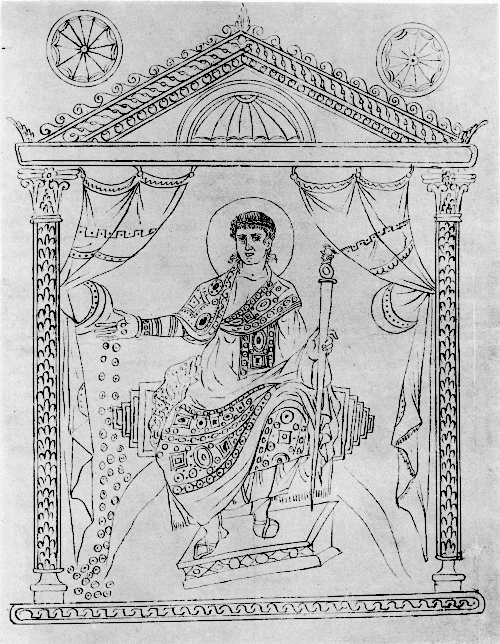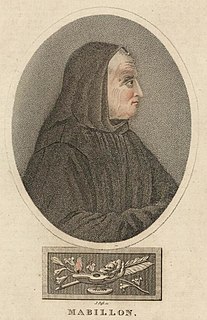
Hippolytus was one of the most important second-third century Christian theologians, whose provenance, identity and corpus remain elusive to scholars and historians. Suggested communities include Palestine, Egypt, Anatolia, Rome and regions of the mideast. The best historians of literature in the ancient church, including Eusebius of Caesarea and Jerome, openly confess they cannot name where Hippolytus the biblical commentator and theologian served in leadership. They had read his works but did not possess evidence of his community. Photios I of Constantinople describes him in his Bibliotheca as a disciple of Irenaeus, who was said to be a disciple of Polycarp, and from the context of this passage it is supposed that he suggested that Hippolytus so styled himself. This assertion is doubtful. One older theory asserts he came into conflict with the popes of his time and seems to have headed a schismatic group as a rival to the Bishop of Rome, thus becoming an Antipope. In this view, he opposed the Roman Popes who softened the penitential system to accommodate the large number of new pagan converts. However, he was reconciled to the Church before he died as a martyr.

Saint Lawrence or Laurence was one of the seven deacons of the city of Rome, Italy, under Pope Sixtus II who were martyred in the persecution of the Christians that the Roman Emperor Valerian ordered in 258.

Saint Denis was a legendary 3rd-century Christian martyr and saint. According to his hagiographies, he was bishop of Paris in the third century and, together with his companions Rusticus and Eleutherius, was martyred for his faith by decapitation. Some accounts placed this during Domitian's persecution and identified St Denis of Paris with the Areopagite who was converted by St Paul and who served as the first bishop of Athens. Assuming Denis's historicity, it is now considered more likely that he suffered under the persecution of the emperor Decius shortly after AD 250. Denis is the most famous cephalophore in Christian legend, with a popular story claiming that the decapitated bishop picked up his head and walked several miles while preaching a sermon on repentance. He is venerated in the Catholic Church as the patron saint of France and Paris and is accounted one of the Fourteen Holy Helpers. A chapel was raised at the site of his burial by a local Christian woman; it was later expanded into an abbey and basilica, around which grew up the French city of Saint-Denis, now a suburb of Paris.

Nicolas-Claude Fabri de Peiresc, often known simply as Peiresc, or by the Latin form of his name Peirescius, was a French astronomer, antiquary and savant, who maintained a wide correspondence with scientists, and was a successful organizer of scientific inquiry. His research included a determination of the difference in longitude of various locations in Europe, around the Mediterranean, and in North Africa.

Sol Invictus was the official sun god of the later Roman Empire and a patron of soldiers. On 25 December AD 274, the Roman emperor Aurelian made it an official cult alongside the traditional Roman cults. Scholars disagree about whether the new deity was a refoundation of the ancient Latin cult of Sol, a revival of the cult of Elagabalus, or completely new. The god was favored by emperors after Aurelian and appeared on their coins until the last third-part of the reign of Constantine I. The last inscription referring to Sol Invictus dates to AD 387, and there were enough devotees in the fifth century that the Christian theologian Augustine found it necessary to preach against them.
The Decretum Gelasianum or the Gelasian Decree is so named because it was traditionally thought to be a Decretal of the prolific Pope Gelasius I, bishop of Rome 492–496. The work reached its final form in a five-chapter text written by an anonymous scholar between 519 and 553, the second chapter of which is a list of books of Scripture presented as having been made Canonical by a Council of Rome under Pope Damasus I, bishop of Rome 366–383. This list, known as the Damasine List, represents the same canon as shown in the Council of Carthage Canon 24, 419 AD.
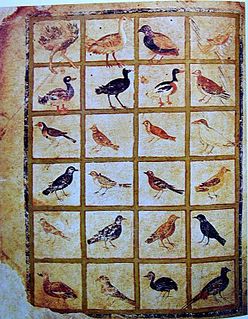
The Vienna Dioscurides or Vienna Dioscorides is an early 6th-century Byzantine Greek illuminated manuscript of De Materia Medica by Dioscorides in uncial script. It is an important and rare example of a late antique scientific text. The 491 vellum folios measure 37 by 30 cm and contain more than 400 pictures of animals and plants, most done in a naturalistic style. In addition to the text by Dioscorides, the manuscript has appended to it the Carmen de herbis attributed to Rufus, a paraphrase of an ornithological treatise by a certain Dionysius, usually identified with Dionysius of Philadelphia, and a paraphrase of Nicander's treatise on the treatment of snake bites.
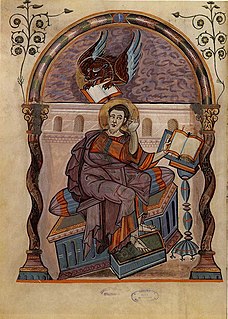
Evangelist portraits are a specific type of miniature included in ancient and mediaeval illuminated manuscript Gospel Books, and later in Bibles and other books, as well as other media. Each Gospel of the Four Evangelists, the books of Matthew, Mark, Luke, and John, may be prefaced by a portrait of the Evangelist, usually occupying a full page. Their symbols may be shown with them, or separately. Often they are the only figurative illumination in the manuscript. They are a common feature in larger Gospel Books from the earliest examples in the 6th century until the decline of that format for illustrated books in the High Middle Ages, by which time their conventions were being used for portraits of other authors.
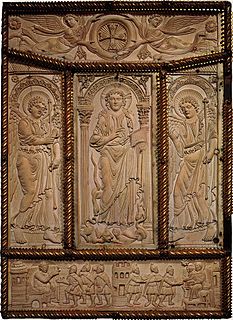
Carolingian art comes from the Frankish Empire in the period of roughly 120 years from about 780 to 900—during the reign of Charlemagne and his immediate heirs—popularly known as the Carolingian Renaissance. The art was produced by and for the court circle and a group of important monasteries under Imperial patronage; survivals from outside this charmed circle show a considerable drop in quality of workmanship and sophistication of design. The art was produced in several centres in what are now France, Germany, Austria, northern Italy and the Low Countries, and received considerable influence, via continental mission centres, from the Insular art of the British Isles, as well as a number of Byzantine artists who appear to have been resident in Carolingian centres.
In compiling the history of the Early Christian Church, the Liberian Catalogue, which was part of the illuminated manuscript known as the Chronography of 354, is an essential document, for it consists of a list of the popes, designated bishops of Rome, ending with Pope Liberius, hence its name and approximate date. The list gives the lengths of their respective episcopates, the corresponding consular dates, and the names of the reigning emperors. In many cases there are other details. "The collection of tracts of which this forms a part was edited in 354" (CE). It now survives only in a copy.

The Martyrologium Hieronymianum or Martyrologium sancti Hieronymi is an ancient martyrology or list of Christian martyrs in calendar order, one of the most used and influential of the Middle Ages. It is the oldest surviving general or "universal" martyrology, and the precursor of all later Western martyrologies.

The Utrecht Psalter is a ninth-century illuminated psalter which is a key masterpiece of Carolingian art; it is probably the most valuable manuscript in the Netherlands. It is famous for its 166 lively pen illustrations, with one accompanying each psalm and the other texts in the manuscript. The precise purpose of these illustrations, and the extent of their dependence on earlier models, have been matters of art historical controversy. The psalter spent the period between about 1000 to 1640 in England, where it had a profound influence on Anglo-Saxon art, giving rise to what is known as the "Utrecht style". It was copied at least three times in the Middle Ages. A complete facsimile edition of the psalter was made in 1875, and another in 1984 (Graz).
The Fasti vindobonenses are two sets of late antique consular annals ("fasti"), found in the Vindobonensis manuscript MS. 3416, together with the Chronography of 354. They were previously known as Anonymus Cuspiniani, since they were published by Johannes Cuspinianus in 1553, and are part of the Consularia Italica collection.
Polemius Silvius was the author of an annotated Julian calendar that attempted to integrate the traditional Roman festival cycle with the new Christian holy days. His calendar, also referred to as a laterculus or fasti, dates to around 448–449. He was active in southeastern Gaul.

In the Roman Empire, the Pelusia was a religious festival held March 20 in honor of Isis and her child Harpocrates. It would have coincided with the second day of the Quinquatria, a five-day festival to Minerva. The holiday was not a part of the Roman calendar before the mid-1st century AD, but had been added by the time of Marcus Aurelius (161–180). It is preserved in the Calendar of Filocalus as an official holiday.
The Gaianum was an area in the Transtiberim in ancient Rome. It is located in Regio XIV, about 300m northwest of the Mausoleum of Hadrian, south of a naumachia thought to have been built by Trajan, and east of the Via Triumphalis. The historian Cassius Dio says that Caligula, also commonly known in ancient sources as Gaius, used the Gaianum for chariot exercises. A number of victory statues have been found in the area, but seem to have been installed originally at the Circus of Gaius and Nero. The Gaianum was probably only a track, not a circus building as such.

